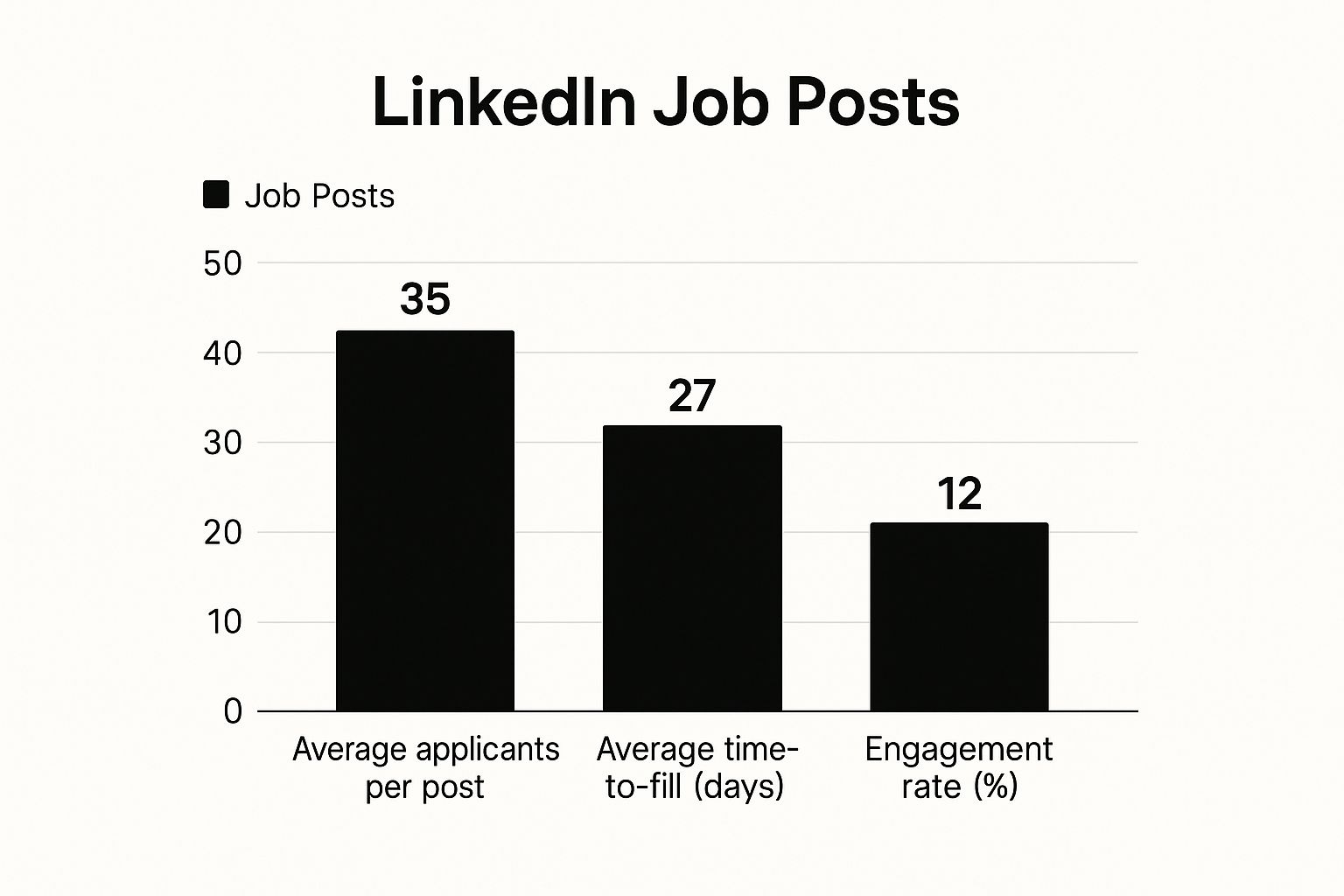Post Jobs on LinkedIn: Guide That Actually Gets Results
- Janis Kolomenskis
- Jun 21
- 10 min read
Updated: Jun 25
Building Your LinkedIn Recruiting Foundation

This platform has become a powerhouse for recruitment, and that's just as true in specific markets like Latvia. Local companies are smartly using LinkedIn's global reach to connect with a wider talent pool, particularly for tech and finance roles. In 2024, an impressive 70% of Latvian recruiters said LinkedIn was their primary tool for sourcing candidates, a figure that’s right in line with global trends. You can dive deeper into LinkedIn's growing role in regional recruitment on columncontent.com. This shows that having a polished, professional presence is no longer just a nice-to-have; it's essential.
Showcase Your Culture, Don’t Just State It
Forget the generic mission statements that everyone skims over. The best way to show off your company culture is to let your own team do the talking. Instead of saying, "we value collaboration," why not post a photo of your team deep in a project brainstorm? Add a quote from a team member about the experience. These authentic snapshots build trust and give candidates a real feel for what it’s like to work with you, making your job posts that much more compelling when they go live.
Streamline Your Team’s Workflow
A well-run page isn't just for candidates; it makes life easier for your hiring team, too. A simple but often-missed step is setting up proper admin permissions. Here’s a quick breakdown:
Super admin: Has complete control over the page, including billing.
Content admin: Can post updates and manage the comment section.
Analyst: Can view performance data without being able to make edits.
By assigning these roles correctly, you empower your marketing crew to handle the content while recruiters have the access they need to post jobs and check the analytics. This simple bit of organisation prevents delays and keeps your page looking active and professional—a win for your internal team and potential applicants alike.
Writing Job Posts That Actually Convert
Let's be real for a moment: a lot of job descriptions sound like they were written by a committee, for a committee. They're stiff, full of jargon, and fail to get anyone excited. When you post jobs on LinkedIn, the secret sauce is changing your perspective. You're not just filling a vacancy; you’re selling an incredible opportunity. The best job posts make a candidate feel like they’ve stumbled upon a role that was made just for them.
This is especially true in a competitive hiring scene. Take Latvia, for example. In 2023, companies posted roughly 15,000 jobs on LinkedIn, which was a 20% jump from the year before. The tech sector was on fire, accounting for almost 40% of those roles. With so much noise, making your post stand out is non-negotiable. You can dig deeper into these numbers and explore more about Latvian hiring trends on analyzify.com.
Craft a Title That Works for You
Your job title is the first handshake. It’s the very first thing a potential candidate sees, so it needs to be easy to find and genuinely appealing. This isn't the time for quirky internal titles or clever wordplay. Stick to standard, recognisable titles that people are actually typing into the search bar. "Digital Overlord" might sound cool to your team, but "Head of Digital Marketing" is what will bring qualified professionals to your door. The aim is to be discovered, not to be confusing.
Take a look at how different parts of a job post can affect your hiring metrics.

The data here is clear. A thoughtfully written post doesn't just pull in more applicants—it boosts engagement and can seriously shorten your time-to-fill.
To really drive this home, let’s look at how different approaches stack up. We've put together a quick comparison based on typical outcomes we've seen.
Job Post Performance Comparison
As you can see, the way you frame your post has a direct impact on not just the number of applications but also their quality and how quickly you can welcome a new team member.
Write for Humans, Not Robots
Once you’ve got their attention with a solid title, the description is your chance to reel them in. Forget the endless, bulleted lists of "must-have" skills that read like a legal document. Instead, try flipping the script with a more human-focused structure:
Lead with the 'Why': Kick things off with a paragraph about your company's mission. What are you building? Why should someone be excited to join you?
Describe the Impact: Don’t just list tasks. Frame the responsibilities in terms of the difference this person will make. Instead of "Manage social media accounts," try something like, "You'll be the voice of our brand across all social platforms, growing and engaging our community."
Show Them the Finish Line: Help candidates picture themselves in the role. Briefly outline what success would look like in their first 30, 60, and 90 days.
This approach turns a dull list of duties into a compelling story about a career path. For even more powerful strategies, check out our guide on how to post a job on LinkedIn with strategies that work.
Mastering LinkedIn's Hidden Posting Features
Simply hitting 'post' and hoping for the best isn't much of a strategy. To really find top-tier talent when you post jobs on [LinkedIn](https://www.linkedin.com/), you have to explore the platform’s more powerful tools. Many recruiters don't realise they're skipping over features that can seriously boost the quality of applicants and cut down on manual admin. It’s all about working smarter, not harder, by letting the platform’s own intelligence do the heavy lifting.
A fantastic place to begin is with LinkedIn’s built-in screening questions. As you set up your job post, you can add questions that automatically filter candidates for you. For example, if you're hiring for a sales role, you could ask, "Do you have a minimum of three years of experience in B2B software sales?" and mark it as a must-have. LinkedIn will then sort applicants into "qualified" and "not qualified" piles, saving you precious hours of reviewing irrelevant CVs.
Optimise for AI-Powered Matching
LinkedIn’s algorithm is always working behind the scenes to connect the right people with the right opportunities. To get it to work in your favour, you need to think like a search engine. Your job post should be packed with the specific skills and keywords that your ideal candidate would have on their profile. So, instead of a vague term like "communication skills," get specific with "stakeholder communication" or "technical writing." This precision helps the AI show your role to professionals who have those exact skills listed.
This is the main dashboard where all your recruitment magic happens.

The interface is pretty straightforward for building a detailed and targeted job post. But don't just stop at the basic fields. Dive into the options for adding specific skills and screening questions—this is where you can truly start to refine your applicant pool right from the beginning.
Timing and Distribution That Gets Noticed
A brilliant job post is only half the battle; when and where you share it can make all the difference. When you post jobs on [LinkedIn](https://www.linkedin.com/), think beyond just hitting the "publish" button. The real goal is to create sustained visibility, especially when your ideal candidates are most active. I’ve found that posting on Tuesday, Wednesday, and Thursday mornings—usually between 8 a.m. and 10 a.m. in the candidate’s local time—gets the best results. It seems to catch professionals just as they're settling in and checking their feeds before the workday chaos begins.
Amplify Your Reach Strategically
Your company’s network is your most powerful recruitment amplifier, so don’t be afraid to use it! A simple way to do this is to encourage your current employees to share the job post with their own networks. A post coming from a colleague always feels more genuine and tends to reach a wider, often more relevant, audience.
Sharing your post in relevant LinkedIn Groups can also be a game-changer, but you have to walk a fine line between contributing and just spamming. Here’s how to do it right:
Don’t just drop a link and run. Briefly introduce the role and mention why you think it’s a fantastic opportunity for that specific community. Personalise it a bit!
Engage with any comments you get. If people ask questions, take the time to give thoughtful answers. This shows you’re an active, engaged recruiter, not just a faceless link-spammer.
The Latvian Recruitment Transformation
Managing Applications Without Losing Your Sanity

A chaotic inbox is more than just a headache for you—it’s a terrible experience for candidates. Think about it: professionals sourced through LinkedIn are 40% less likely to leave within the first six months. That relationship starts the moment they apply. You simply can't let fantastic talent fall through the cracks because your follow-up process is a mess. Having a structured approach isn't just nice; it's essential.
Building Bridges, Not Burning Them
Ah, the "thanks, but no thanks" email. It's one of the trickiest parts of recruitment. A cold, generic rejection can leave a sour taste and damage your reputation. Instead of a blunt dismissal, try to build a connection. A simple, thoughtful message makes a world of difference. For example, "While we've decided to move forward with candidates whose experience is a closer match for this specific role, we were genuinely impressed with your project management background. We'd love to stay in touch for future openings" is a much better approach.
This human-first touch is vital for nurturing a strong talent pipeline. A candidate who isn't the right fit today might be the perfect person for a different role in six months. Don't close the door on them.
The speed and quality of your communication directly influence a candidate's perception of your company. The table below shows just how much response time matters.
| Candidate Response Time Impact | | :--- | :--- | :--- | :--- | | Response Time | Candidate Engagement | Offer Acceptance Rate | Employer Brand Rating | | Within 24 hours | High (Feels valued) | Increases by up to 15% | Very Positive | | 2-4 days | Moderate (Starts to decline) | Stable | Neutral | | 5-7 days | Low (Assumes disinterest) | Decreases by 10% | Slightly Negative | | Over 1 week | Very Low (Likely lost) | Drops by over 20% | Negative |
As the data shows, a prompt and personal response doesn't just keep candidates interested; it directly boosts your chances of them accepting an offer and improves how they view your brand.
Keeping Top Candidates Engaged
What do you do when the hiring process inevitably slows down? Radio silence is your worst enemy. Keep your strongest candidates in the loop with short, consistent updates. A quick weekly email can work wonders.
Acknowledge the wait: "Just a quick note to let you know you're still very much in consideration. Our team is wrapping up interviews, and we really appreciate your patience."
Offer a timeline: "We're aiming to have our next steps finalised by the end of next week."
This simple act of communication demonstrates respect for their time and keeps them excited about the role. It stops them from accepting another offer just because they felt ignored by you.
Measuring What Actually Matters for Hiring Success
When you post jobs on LinkedIn, it’s so easy to get fixated on vanity metrics, especially the number of applications flooding in. But let's be honest, a huge pile of CVs doesn't mean you've found the right person. Real success comes down to the quality of the hire and the impact they have on your team in the long run. Shifting your focus to the right performance indicators is what truly separates a decent hiring process from a great one.
Think about what happens after the offer letter is signed. That's where the real story unfolds. For instance, data shows that employees sourced through LinkedIn are 40% less likely to leave within their first six months. This stat alone tells us that the measurement shouldn't stop when the role is filled. The true test is in retention, performance, and how well they gel with your team.
Look Beyond Surface-Level Analytics
LinkedIn's job post analytics are a good starting point, but the goldmine of insights is found when you connect that data to your internal results. Instead of just counting applicants, start digging into where your best hires actually come from. Which channels brought in the superstars? Do you notice any patterns in the profiles of candidates who not only accept offers but thrive in their roles?
Here are a few key metrics I always recommend prioritising:
Quality of Hire: This is your north star metric. Keep an eye on performance reviews, project outcomes, and cultural fit after three to six months. Did your LinkedIn post genuinely attract the talent you were hoping for?
Source of Hire: Pinpoint exactly which platforms are delivering your best long-term team members. Was it a direct application from your LinkedIn ad, a referral from a current employee, or maybe a specific LinkedIn Group you engaged with?
Candidate Satisfaction: A simple survey can reveal a lot about the applicant experience. A positive journey, even for candidates you don't hire, does wonders for your employer brand.
By tracking these deeper metrics, you can start to refine your strategy for every new job post. It ensures you’re not just filling a seat, but attracting people who will help drive your business forward. For a deeper dive, check out our guide on the essential recruiting metrics to improve hiring in 2025.
Your Action Plan for LinkedIn Recruiting Success
Taking all this new knowledge and putting it into action can feel a bit much, but breaking it down makes it manageable. A great starting point is to focus on just one thing: rewriting your job descriptions to sound more human. Give yourself a goal to refresh three posts this week. You'll know you're on the right track when you see a clear rise in qualified applicants over the next 30 days.
Once you've got the hang of that, you can post jobs on LinkedIn with a fresh distribution plan. For instance, try sharing roles in two relevant industry groups and ask your team to share one opening each week. This creates a ripple effect and builds momentum. As you fine-tune your outreach, remember that candidates are also levelling up their game. You can get inside their heads by reading up on LinkedIn job search mastery to land a dream role.
Ready to turn your recruitment chaos into a smooth, strategic operation? Discover how Yena’s Hiring OS can make all the difference.

Comments